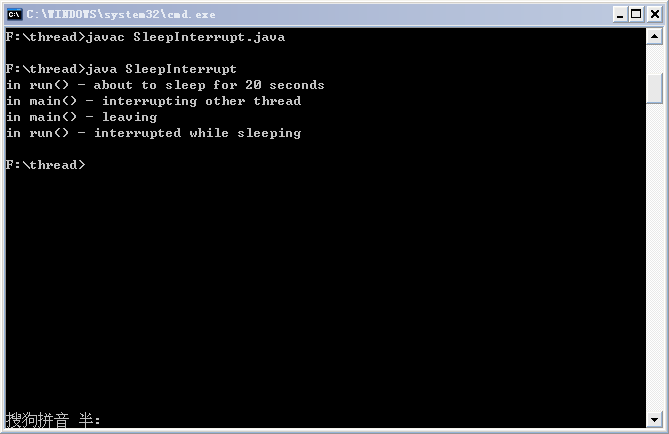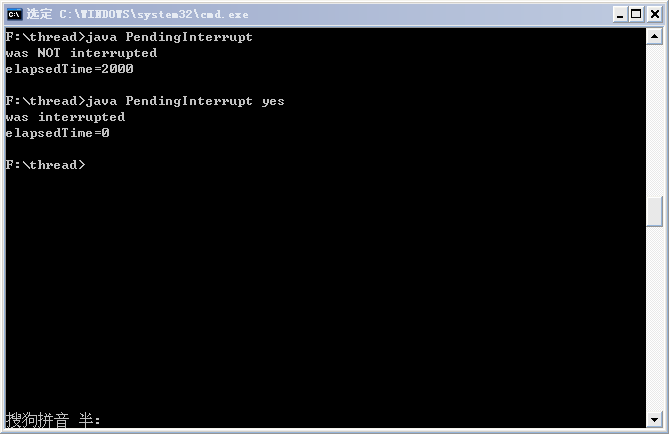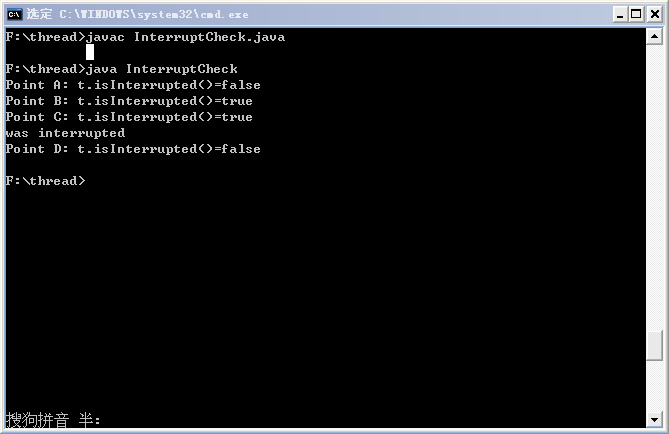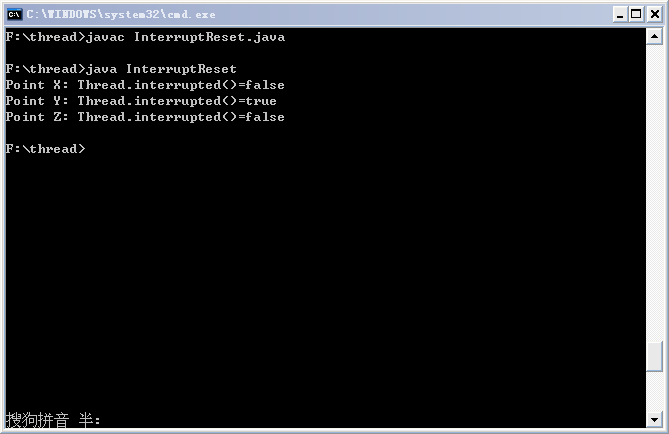您好,登錄后才能下訂單哦!
您好,登錄后才能下訂單哦!
如何在Java中切斷線程?很多新手對此不是很清楚,為了幫助大家解決這個難題,下面小編將為大家詳細講解,有這方面需求的人可以來學習下,希望你能有所收獲。
使用interrupt()切斷線程
當一個線程運行時,另一個線程可以調用對應的Thread對象的interrupt()方法來中斷它,該方法只是在目標線程中設置一個標志,表示它已經被中斷,并立即返回。這里需要注意的是,如果只是單純的調用interrupt()方法,線程并沒有實際被中斷,會繼續往下執行。
下面一段代碼演示了休眠線程的中斷:
public class SleepInterrupt extends Object implements Runnable{
public void run(){
try{
System.out.println("in run() - about to sleep for 20 seconds");
Thread.sleep(20000);
System.out.println("in run() - woke up");
}catch(InterruptedException e){
System.out.println("in run() - interrupted while sleeping");
//處理完中斷異常后,返回到run()方法人口,
//如果沒有return,線程不會實際被中斷,它會繼續打印下面的信息
return;
}
System.out.println("in run() - leaving normally");
}
public static void main(String[] args) {
SleepInterrupt si = new SleepInterrupt();
Thread t = new Thread(si);
t.start();
//主線程休眠2秒,從而確保剛才啟動的線程有機會執行一段時間
try {
Thread.sleep(2000);
}catch(InterruptedException e){
e.printStackTrace();
}
System.out.println("in main() - interrupting other thread");
//中斷線程t
t.interrupt();
System.out.println("in main() - leaving");
}
} 運行結果如下:

主線程啟動新線程后,自身休眠2秒鐘,允許新線程獲得運行時間。新線程打印信息“about to sleep for 20 seconds”后,繼而休眠20秒鐘,大約2秒鐘后,main線程通知新線程中斷,那么新線程的20秒的休眠將被打斷,從而拋出InterruptException異常,執行跳轉到catch塊,打印出“interrupted while sleeping”信息,并立即從run()方法返回,然后消亡,而不會打印出catch塊后面的“leaving normally”信息。
請注意:由于不確定的線程規劃,上圖運行結果的后兩行可能順序相反,這取決于主線程和新線程哪個先消亡。但前兩行信息的順序必定如上圖所示。
另外,如果將catch塊中的return語句注釋掉,則線程在拋出異常后,會繼續往下執行,而不會被中斷,從而會打印出”leaving normally“信息。
待決中斷
在上面的例子中,sleep()方法的實現檢查到休眠線程被中斷,它會相當友好地終止線程,并拋出InterruptedException異常。另外一種情況,如果線程在調用sleep()方法前被中斷,那么該中斷稱為待決中斷,它會在剛調用sleep()方法時,立即拋出InterruptedException異常。
下面的代碼演示了待決中斷:
public class PendingInterrupt extends Object {
public static void main(String[] args){
//如果輸入了參數,則在mian線程中中斷當前線程(亦即main線程)
if( args.length > 0 ){
Thread.currentThread().interrupt();
}
//獲取當前時間
long startTime = System.currentTimeMillis();
try{
Thread.sleep(2000);
System.out.println("was NOT interrupted");
}catch(InterruptedException x){
System.out.println("was interrupted");
}
//計算中間代碼執行的時間
System.out.println("elapsedTime=" + ( System.currentTimeMillis() - startTime));
}
} 如果PendingInterrupt不帶任何命令行參數,那么線程不會被中斷,最終輸出的時間差距應該在2000附近(具體時間由系統決定,不精確),如果PendingInterrupt帶有命令行參數,則調用中斷當前線程的代碼,但main線程仍然運行,最終輸出的時間差距應該遠小于2000,因為線程尚未休眠,便被中斷,因此,一旦調用sleep()方法,會立即打印出catch塊中的信息。執行結果如下:

這種模式下,main線程中斷它自身。除了將中斷標志(它是Thread的內部標志)設置為true外,沒有其他任何影響。線程被中斷了,但main線程仍然運行,main線程繼續監視實時時鐘,并進入try塊,一旦調用sleep()方法,它就會注意到待決中斷的存在,并拋出InterruptException。于是執行跳轉到catch塊,并打印出線程被中斷的信息。最后,計算并打印出時間差。
使用isInterrupted()方法判斷中斷狀態
可以在Thread對象上調用isInterrupted()方法來檢查任何線程的中斷狀態。這里需要注意:線程一旦被中斷,isInterrupted()方法便會返回true,而一旦sleep()方法拋出異常,它將清空中斷標志,此時isInterrupted()方法將返回false。
下面的代碼演示了isInterrupted()方法的使用:
public class InterruptCheck extends Object{
public static void main(String[] args){
Thread t = Thread.currentThread();
System.out.println("Point A: t.isInterrupted()=" + t.isInterrupted());
//待決中斷,中斷自身
t.interrupt();
System.out.println("Point B: t.isInterrupted()=" + t.isInterrupted());
System.out.println("Point C: t.isInterrupted()=" + t.isInterrupted());
try{
Thread.sleep(2000);
System.out.println("was NOT interrupted");
}catch( InterruptedException x){
System.out.println("was interrupted");
}
//拋出異常后,會清除中斷標志,這里會返回false
System.out.println("Point D: t.isInterrupted()=" + t.isInterrupted());
}
} 運行結果如下:

使用Thread.interrupted()方法判斷中斷狀態
可以使用Thread.interrupted()方法來檢查當前線程的中斷狀態(并隱式重置為false)。又由于它是靜態方法,因此不能在特定的線程上使用,而只能報告調用它的線程的中斷狀態,如果線程被中斷,而且中斷狀態尚不清楚,那么,這個方法返回true。與isInterrupted()不同,它將自動重置中斷狀態為false,第二次調用Thread.interrupted()方法,總是返回false,除非中斷了線程。
如下代碼演示了Thread.interrupted()方法的使用:
public class InterruptReset extends Object {
public static void main(String[] args) {
System.out.println(
"Point X: Thread.interrupted()=" + Thread.interrupted());
Thread.currentThread().interrupt();
System.out.println(
"Point Y: Thread.interrupted()=" + Thread.interrupted());
System.out.println(
"Point Z: Thread.interrupted()=" + Thread.interrupted());
}
} 運行結果如下:

從結果中可以看出,當前線程中斷自身后,在Y點,中斷狀態為true,并由Thread.interrupted()自動重置為false,那么下次調用該方法得到的結果便是false。
補充
這里補充下yield和join方法的使用。
join方法用線程對象調用,如果在一個線程A中調用另一個線程B的join方法,線程A將會等待線程B執行完畢后再執行。
yield可以直接用Thread類調用,yield讓出CPU執行權給同等級的線程,如果沒有相同級別的線程在等待CPU的執行權,則該線程繼續執行。
看完上述內容是否對您有幫助呢?如果還想對相關知識有進一步的了解或閱讀更多相關文章,請關注億速云行業資訊頻道,感謝您對億速云的支持。
免責聲明:本站發布的內容(圖片、視頻和文字)以原創、轉載和分享為主,文章觀點不代表本網站立場,如果涉及侵權請聯系站長郵箱:is@yisu.com進行舉報,并提供相關證據,一經查實,將立刻刪除涉嫌侵權內容。